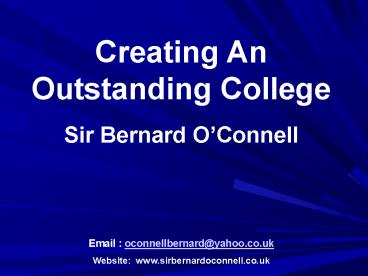Creating An Outstanding College PowerPoint PPT Presentation
1 / 27
Title: Creating An Outstanding College
1
Creating An Outstanding College Sir Bernard
OConnell Email oconnellbernard_at_yahoo.co.uk We
bsite www.sirbernardoconnell.co.uk
2
Runshaw College
Sixth Form Centre 3,750
RBC 1.5m
Adult College
1,000 Access 2 Prisons 1,000 ABE 700 Stepping
Stones 4,000 Part-Time 350 HE
900 staff
3
99
88
67
1974
1984
1994
2004
4
Runshaws Achievements
- Beacon College Joint Best Inspection Reports in
FE in 1996, 2001 2005 - Growth from 900 to 14,000
- Success rates 10 above national benchmark
- Very high student satisfaction
- 90-95 staff satisfaction each year
- Grade A finances and 10m building spend
- UK (2002) and European Quality Award (2003)?
- EFQM European Prize for Leadership, 2003
5
Audit Commission (1983)?
- Obtaining better value from F.E. (1985)?
- 50 million year wasted 75,000 more students at
no significant extra cost - Better marketing over teaching small class
sizes lecturer teaching hours financial
management space MIS - N.B. 1993 report on 16-19 150,000 leave/ fail
330 million
6
Government frustrations about the culture of
education
- HMI identified widespread poor teaching
- Unacceptable variations between and within
colleges - Lack of leadership
- Quality assurance left to chance
- Professional culture the root of the problem
- Professionalism interpreted as
unaccountability
7
Management
- Not Managing
Fractured
- Lecturers
- Unaccountable
- Non-Compliance
- Doing Their Own Thing
- Poor / Mediocre Performance
8
Essentials for Quality Control
9
Systems for Quality Control
10
Three challenges
- Do you have these quality controls?
- If you do, are they best practice, producing
valid reliable results? - 3. Does everyone implement them properly? That
is, the D in - RADAR
11
Management
Teachers
Students
12
Examples of changes that challenged the culture
of individual autonomy
- External
- Inspection grades and published reports
- League Tables
- Targets Benchmarking
- Business Values
- - Funding students, not institutions
- - Market Forces
- - Value for Money
- - Accountability
- Pay and Conditions
- Some Internal QA Processes
- Performance Measurement
- - Lesson observation
- - Data
- - Student surveys
- Performance Management
- Poor performance
- Self-Assessment/Action Plan
- Teamwork
- Mandatory Staff Development
13
The new reality
- All the new approaches (e.g. lesson observation)
DO promote critical judgements of colleagues
work, disturbing the comfortable and congenial
culture of individualism. - The challenge and problem was and is to
transform the culture with a form of leadership
that carries people with you. - WHAT HAPPENED IN COLLEGES?
14
What Happened In Colleges?
- Culture change
- Managerialism
- Polarisation of senior managers and staff
15
Command and Control Management
Manager
- Isolated
- Decisions
- Standards
- Out of Touch
- Targets
- Budgets
Push
Teachers serve the hierarchy, not students
16
Staff Become Negative Or Give Up
Cautious Leadership Keep Your Head Down
Cynicism Withdrawal
Resistance to Change
Command and Control
Blaming Demotivated
Climate Of Fear
Staff Do Minimum
17
Doing the wrong thing
- Command Control
- creates a vicious circle in which management
becomes control rather than the creation of
resources so busy chasing targets that they have
no time to do the work that matters for
(students) - .Inherent in command control is the assumption
that human beings cant be trusted on their own
to do what is needed. Hierarchy and tight
supervision are required to tell them what to do.
So, in a self-fulfilling prophecy, fear-driven,
hierarchical organisations turn people into
untrustworthy opportunistsand the control-freaks
say, I told you so. - (Simon Caulkin)?
18
The 7 Ss
STRATEGY
SYSTEMS
- 3 HARD Ss
- 1990-93
- logical
- technical
- observable
- tools
- techniques
- methodologies
STRUCTURE
19
Critical Success Factors
Stakeholders
Mission Statements
Empowerment
Briefing
Teams
Communications Systems
Performance Management
IIP
Death by 1000 Management Initiatives
Statistical Process Control
TQM
Customer Surveys
Process Re-engineering
Recognition Strategies
Benchmarking
Environmental Management
Focus Groups
Suggestion Scheme
20
The 7 Ss
- 3 HARD Ss
- logical
- technical
- observable
- tools
- techniques
- methodologies
- 4 Soft Ss
- creative
- intuitive
- cultural
STRATEGY
SYSTEMS
STRUCTURE
STAFF
STYLE
SHARED VALUES
SKILLS
21
Student Demands
One Stop Transactions
PUL L
FLOW
22
Transformational Leadership
Transactional Leadership
Versus
Command Control
Winning Hearts Minds
23
Transformational leadership a definition
- is concerned with engaging the hearts and minds
of others. It works to help all parties achieve
greater motivation, satisfaction and a greater
sense of achievement. It requires trust, concern
and facilitation rather than direct control. The
skills required are concerned with establishing a
long-term vision, empowering people to control
themselves, coaching, developing others and
challenging the culture to change. In
transformational leadership, the power of the
leader comes from creating understanding and
trust. In contrast, in transactional leadership,
power is based on the notion of hierarchy and
position. -
Professor John Mackness
24
Translating a value into behaviours
What does the value mean? what beliefs does it
imply?
Managers
Students
25
PROFESSIONAL LEARNING COMMUNITY
ONE UNITED MANAGEMENT TEAM
SMT
ONE UNITED STAFF TEAM
MIDDLE MANAGERS
TEAM LEADERS
STAFF
STUDENTS
OTHER STAKEHOLDERS
26
Management Style
HR Strategy
How do you make people feel valued?
27
Designing a culture change programme for your
service
- 1. Gain understanding of the concepts of
transformational leadership develop a
systematic implementation plan. - 2. Health check, especially the barriers for
middle managers. - 3. Create one united management team
- 4. Identify the core values, translate into
explicit behaviours embed into your processes.
28
- 5. Develop HR strategies to Make people feel
valued. - 6. Involve all staff in developing a shared sense
of direction. - 7. Develop a process management model that
improves relationships between support staff and
teaching staff. - 8. And define Grade 1 Excellence in the
classroom.

